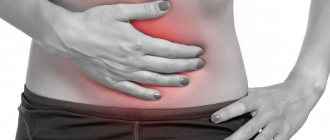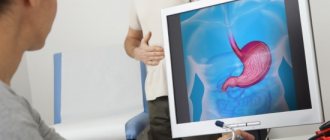Types of odor from the mouth
An unpleasant odor most often appears due to poor oral hygiene or consumption of foods with strong aromas. After brushing your teeth, the problem is eliminated.
If the smell remains, it may be a symptom of serious pathologies of internal organs:
- rotten - a sign of gastritis, can also signal a helminthic infestation of the body;
- sour - a common symptom of gastrointestinal diseases such as ulcers of various etiologies, pancreatitis;
- bitter - may accompany hepatitis (an additional sign is a yellow coating on the tongue), as well as pathologies of the bile ducts;
- fecal – notifies about the presence of dysbacteriosis;
- the smell of acetone is a clear manifestation of diabetes and can signal serious problems with the kidneys (cystitis, nephrosis) and the thyroid gland;
- the aroma of laundry soap is a sign of stagnation of bile in the body;
- iron smell, metallic taste – problems with the digestive system (intestines, stomach, liver), can accompany diseases such as anemia and hypovitaminosis.
If you have no idea how to find out if your breath smells bad, use our proven methods.
Medical diagnosis
High-quality dental treatment, carried out in a timely manner, reduces the risk of bad breath. At an early stage, it is easier to cure caries, gingivitis, and periodontitis than to fight the chronic form of the disease. Therefore, visit the dentist regularly – once every six months. During preventive examinations, the hygienist removes plaque, sanitizes the oral cavity, and prevents disease of the gums and chewing organs.
You can find out whether your breath smells or not using diagnostic procedures.
- Patients are advised to undergo examination by a dentist.
- The intensity of bad breath is assessed using a halimeter.
- Pathogenic microorganisms are identified during microbiological studies.
- The otolaryngologist consults the patient if there are ENT diseases or an inflamed nose.
- A gastroenterologist examines to exclude pathologies of the digestive system.
To determine odor, not only sulfide monitoring is carried out. The doctor carefully examines the patient’s oral cavity, larynx, and nasopharynx. Diagnostics also includes:
- general urine, stool and blood tests;
- biochemical blood test;
- bacteriological study of oral plaque;
- colonoscopy, endoscopy;
- abdominal ultrasound;
- manometry;
All this allows you to make an accurate diagnosis and prescribe the correct therapy, which leads to recovery and the disappearance of bad breath.
How to determine your breath odor
Checking whether there is bad breath is quite simple. There are methods available at home as well as diagnosing halitosis (the scientific name for stench) in a medical facility.
Independent methods allow you to feel the persistent unpleasant odor.
Subtle aromas can only be detected by special devices.
Self-identification
For the test, you can use any container intended for drinking.
Options for how to check for an unpleasant odor in yourself:
- Own palms. You need to cup your hands and bring them to your face (imagine that you want to sneeze). Take a deep breath, exhale as fully as possible into your palms. If there is a stench, it will be immediately felt.
- Medical mask. The method is similar to the previous one, only a disposable mask is used instead of palms. You need to put it on your face and take a deep breath.
- The maximum accumulation of harmful bacteria is located at the root of the tongue. You need to take an ordinary spoon (teaspoon, table spoon, dessert spoon) and run it along the surface of the tongue as close as possible to its root, but so as not to provoke a gag reflex. Now smell the spoon.
- Saliva completely reflects the “situation” in the oral cavity. You need to lick your wrist, wait a few seconds and smell. The main thing is that before the test your hands do not smell of anything (soap, creams, antiseptic wipes, perfume).
- If you don't know how to figure out what your breath smells like, go to your own kitchen. Place a cup, mug or bowl on the nasolabial triangle and exhale as much as possible. Immediately inhale and determine how fresh your breath is.
- Dental floss. With this dental accessory you need to clean the interdental space. Then just sniff the thread.
- Fleece or gauze. You need to fold the gauze into a compact tampon or form a small round piece of cotton wool. Place it on your tongue and wait until it is a little saturated with saliva, and then take it out and smell it.
If you do not trust home methods, but do not know how to determine the presence of bad breath, you need to resort to the developments of modern medicine.
How to find out if a person’s breath smells: 4 effective ways
Bad breath is called halitosis, and, as a rule, it is only a consequence of problems in our body. However, there are ways that show how to find out if a person’s breath smells, and immediately pay attention to possible malfunctions in the functioning of human systems.
An unpleasant odor can be caused by:
- Diseases of the stomach and digestive tract.
- Advanced cases of caries.
- Reduced secretion of saliva.
- ENT diseases.
- Periodontitis.
But also don’t forget that bad breath can also occur when you simply don’t brush your teeth well or eat odorous foods like garlic.
How to find out if your breath smells or not yourself
There are 4 simple ways that will allow you to draw the right conclusions about the purity of your breath.
Method No. 1
You need to touch the middle of your tongue to your wrist and after 20 seconds sniff the skin. If the smell is not very fresh, then you need to take action.
Method No. 2
Run your finger down the middle of your tongue, wait for it to dry, and then take a deep breath to see if there is a stale smell.
However, remember that both of these methods will not be reliable if you use them immediately after brushing with toothpaste. But conducting such a test during the day is the most optimal solution.
How to find out if there is bad breath using a cup.
Method No. 3
• Have an empty cup ready.
• Take a deep breath.
• Exhale into the empty cup.
• Immediately smell the smell in this container.
There are variations of this method using your own palm instead of a cup, but the option of using dishes is still more successful, since no other odors are mixed in, for example, the smell of your own palm.
How to find out your breath odor using a spoon.
Method No. 4
Scrape the plaque on your tongue with a regular spoon or a special spatula, and then evaluate its color. If it is dark, then there is definitely an unpleasant smell.
You can do a similar procedure using dental floss. In this case, you need to brush your teeth with this floss and smell it.
And remember, bad breath is not a death sentence at all, and to remove it, use the following tips:
• Rinse your mouth after every meal.
• Chew sugarless gum for 10 minutes.
• Avoid eating foods with strong odors.
And, just in case, visit a gastroenterologist to make sure that the cause of the unpleasant odor is not related to problems in the gastrointestinal tract.
Share useful information with your friends, let them know too!
data-matched-content-rows-num=”4.2″ data-matched-content-columns-num=”1.3″
Types of halitosis
During the process of inhalation and exhalation, the human body releases various waste products. Halitosis, depending on the causes of its occurrence, is divided into several types:
- physiological - occurs due to putrefactive plaque, which consists of pathogenic flora and forms on the tongue and the back wall of the palate;
- pathological – occurs due to diseases of the oral cavity and organs;
- pseudohalitosis - a person, checking his breath, always detects an unpleasant odor, but in fact it is absent.
The latter type of pathology often occurs in those who previously suffered from halitosis, but successfully got rid of it. Now a person is regularly haunted by paranoia that his breath smells bad.
Main signs of bad breath
A person cannot always feel for himself whether there is an unpleasant odor. This is indicated by accompanying signs and factors :
- pronounced white coating, increasing towards the root of the tongue;
- thick and viscous saliva, as well as coughing up sputum;
- constant runny nose;
- burning tongue in the morning, bad breath and severe dryness after waking up;
- the presence of round formations on the tonsils;
- when talking, people try to move away or turn their heads away;
- after beer, coffee, milk or mouthwash, an unpleasant aftertaste occurs;
- there is a feeling of metal, bitterness or acid in the mouth;
- scraping does not remove white plaque from the root;
- Brushing and flossing will not relieve halitosis.
Types of bacteria that cause odor
A person’s breath begins to smell unpleasant due to the formation of chemicals and the colonization of the cavity by microorganisms. The most popular chemicals: hydrogen sulfide, skatole, cadavrine, methyl mercaptan .
Anaerobic bacteria are microorganisms that secrete these products. They develop in places where there is no oxygen. The mucous membrane in the oral cavity is home to millions of beneficial molecules, as well as harmful microorganisms. When failures or illnesses occur, the number of harmful inhabitants increases sharply. As a result, unpleasant symptoms appear.
If white plaque constantly accumulates , then the number of beneficial single-celled organisms decreases sharply. After all, under this film there is no oxygen at all - an ideal environment for dangerous microorganisms that cause bad breath.
Why do anaerobic bacteria survive?
A natural product for the reproduction of harmful inhabitants that cause odor is protein. If a person makes up his diet from dishes with a large amount of meat and eggs, then microorganisms receive enough food for active reproduction.
After a good “lunch”, microorganisms release chemical compounds in large quantities that cause halitosis . But even without an abundance of meat on the menu, a person can feel an unpleasant odor as a result of the proliferation of flora that consume salivary cells and dead particles of the mucous membrane.
Where do bacteria accumulate the most?
The “richest” organ for flora is the tongue. Microbes are localized closer to the root, in the back area, causing a strong odor from the mouth. Another area is periodontal sources.
These include the area between the teeth, which is difficult to clean without flossing. If a person suffers from gum disease, then the number of anaerobic areas increases significantly - bacteria penetrate deep into the area in front of the gum.
Method No. 3
- Prepare an empty cup.
- Take a deep breath.
- Exhale into the empty cup.
- Immediately smell the smell in this container.
There are variations of this method using your own palm instead of a cup, but the option of using dishes is still more successful, since no other odors are mixed in, for example, the smell of your own palm.
How to find out your breath odor using a spoon.
Causes of bad breath
There are many reasons.
- One of them is eating food with an unpleasant odor. These are the well-known onions and garlic, herring, adjika, etc. But bad breath can be caused by seemingly harmless foods such as cheese, coffee, sugar and milk. Why? The fact is that these products contain proteins. And under the influence of oral bacteria they are converted into unpleasant odors.
- In general, the problem of bad breath is often associated with the oral cavity. The odor can be caused by dental diseases (caries). A lot of bacteria accumulate on the inside of the tongue, which helps our food cause unpleasant odors. Therefore, you need to carefully monitor your oral cavity, brush not only your teeth, but also your tongue, and rinse your mouth with special products.
- Another important reason may be hunger or thirst.
- It is also very important to check if everything is in order with your gastrointestinal tract. After all, an unpleasant odor can also cause illness of any internal organs.
Method No. 4
Scrape the plaque on your tongue with a regular spoon or a special spatula, and then evaluate its color. If it is dark, then there is definitely an unpleasant smell.
You can do a similar procedure using dental floss. In this case, you need to brush your teeth with this floss and smell it.
And remember, bad breath is not a death sentence at all, and to remove it, use the following tips:
- Rinse your mouth after every meal.
- Chew sugarless gum for 10 minutes.
- Do not eat foods with a strong smell.
And, just in case, visit a gastroenterologist to make sure that the cause of the unpleasant odor is not related to problems in the gastrointestinal tract.
Source
Similar articles
- 7 ways to get rid of bad breath What to do if you are worried about bad breath and you have an important meeting? In such…
- Why are low-fat foods dangerous for humans? Low-fat foods are not only not healthy for humans, but also pose hidden dangers.…
- RASPBERRY JAM: 2 METHODS OF PREPARATION It’s not for nothing that they say that a jar of raspberry jam will lift your spirits. But to cook it correctly, you need to know...
How to get rid of odor from dental problems
As already mentioned, almost all diseases of the oral cavity lead to the release of an unpleasant odor when speaking. Dental problems are no exception, therefore, with the development of caries, periodontal disease, pulpitis, gumboil, etc. inflammation occurs, which in addition to pain also causes halitosis.
After solving a dental problem, fresh breath usually returns. The main thing that needs to be taken into account is a timely visit to a specialist so that the purulent-destructive process does not affect healthy areas of the dentition.
In addition, it is worth remembering that dentures and implants also require care, so it is important to rinse, clean and disinfect them in a timely manner.











